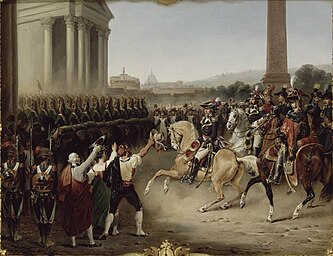Roman Republic (1798–1799)
This article needs additional citations for verification. (May 2023) |
Roman Republic Repubblica Romana (Italian) | |||||||||||||
|---|---|---|---|---|---|---|---|---|---|---|---|---|---|
| 1798–1799 | |||||||||||||
| Motto: Il popolo solo è sovrano ( Revolutionary France | |||||||||||||
| Capital | Rome | ||||||||||||
| Common languages | Italian | ||||||||||||
| Government | Directorial Republic | ||||||||||||
| Directory | |||||||||||||
• 1798–99 | Roman Directory | ||||||||||||
| Legislature | Legislative Council | ||||||||||||
| Historical era | French Revolutionary Wars | ||||||||||||
| 18 February 1798 | |||||||||||||
| invasion | 30 September 1799 | ||||||||||||
| Currency | Roman scudo, Roman baiocco | ||||||||||||
| |||||||||||||
| Today part of | |||||||||||||
Annexation of Rome
The

After crossing the Alps in April 1796 and defeating the Piedmontese army on 12 April 1796 in the Battle of Montenotte and on 21 April 1796 in the Battle of Mondovì, Bonaparte turned his attention south of Piedmont to deal with the Papal States. Bonaparte, skeptical over divided command for the invasion, sent two letters to the Directory. The letters let the Directory relent the invasion for a while. The Austrians were defeated at the Battle of Lodi on 10 May 1796 and retreated to Minico. Under the Treaty of Tolentino, signed on 19 February 1797, Rome was forced to accept an ambassador of the French First Republic.[1] In February 1798, the French invaded the Papal States, motivated by the killing of French general Mathurin-Léonard Duphot in December 1797. After the successful invasion, the Papal States became a French satellite republic renamed as the "Roman Republic", under the leadership of Louis-Alexandre Berthier, one of Bonaparte's generals.[2] Pope Pius VI was taken prisoner, escorted out of Rome on 20 February 1798 and exiled to France, where he later died.
However, plagued by internal struggles, the Roman Republic did not last long and popular support for it was low. On 29 November 1798, the very day that the 1798–1802
Following an invasion from the army of the Kingdom of Naples on 30 September 1799, the Papal States were restored under the rule of Pope Pius VII in June 1800.[3] The French Revolutionary Army invaded the Papal States again in 1808, after which it was divided between the First French Empire and the Napoleonic Kingdom of Italy until the end of the Napoleonic Wars in 1815.
Government
The Roman Republic's constitutional organization of powers was heavily influenced by that of the French Constitution of 1795, which itself was inspired by and loosely based on that of the ancient Roman Republic. Executive authority was vested in a Consulate consisting of five consuls. The legislative branch was composed of two chambers, a 60-member Tribunate and a 30-member Senate, which elected the consuls.[4]
See also
- Consulate of the Roman Republic (1798–1800)
- List of historic states of Italy
- Napoleonic looting of art
- Unification of Italy (1848–1871)
References
- ^ Imperial City: Rome under Napoleon, Susan Vandiver, (p. 20)
- ^ "Napoleon's Campaign in Italy, 1796–97".
- ^ Imperial City: Rome under Napoleon, Susan Vandliver, (p. 21)
- ^ Ogg, Frederick Austin (1913). The Governments of Europe. New York: Macmillan Company. pp. 354–355. Retrieved 3 February 2018.
- Historyofwar.com
- Imperial City: Rome under Napoleon, Susan Vandiver Nicassio, (October 15, 2009, University of Chicago Press), {pp. 20 to 21}



